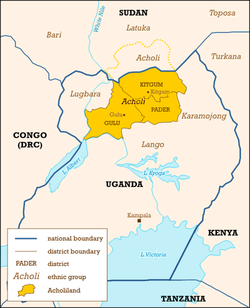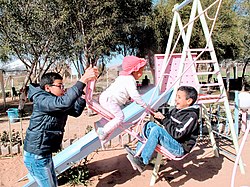Difference between revisions of "AY Honors/African Lore/Answer Key"
| (10 intermediate revisions by the same user not shown) | |||
| Line 1: | Line 1: | ||
| − | + | [[Image:Acholiland,_Uganda.png|thumb|right|250px|Acholiland, Uganda]] | |
| − | + | '''Acholi''' (also '''Acoli''') are the people of the districts of [[Gulu]], [[Kitgum]] and [[Pader District|Pader]], a region known as [[Acholiland]] in northern [[Uganda]] and in Magwe County in southern [[Sudan]] numbering about thirty to fifty thousand people. | |
| − | |||
| − | | | ||
| − | | | ||
| − | |||
| − | |||
| − | |||
| − | |||
| − | + | ==Language== | |
| + | {{main|Acholi language}} | ||
| − | + | The [[Acholi language]] is a [[Western Nilotic languages|Western Nilotic]] language, classified as [[Luo languages|Luo]], and is [[mutually intelligible]] with [[Lango]] and other Luo languages. | |
| − | The | + | The ''[[Song of Lawino|Song of Lawino]]'', one of the most successful African literary works, was written by [[Okot p'Bitek]] in Acholi, and later translated to [[English language|English]]. |
| − | == | + | ==History== |
| − | + | {{see also|Luo}} | |
| − | + | The Acholi are a Luo people, who are said to have come to northern Uganda from the area now known as [[Bahr el Ghazal]] in southern [[Sudan]]. Starting in the late [[seventeenth century]], a new sociopolitical order developed among the Luo of northern Uganda, mainly characterized by the formation of chiefdoms headed by ''Rwodi'' (sg. Rwot, 'ruler'). By the mid-[[nineteenth century]], about 60 small chiefdoms existed in eastern Acholiland{{ref|webster}}. During the second half of the nineteenth century [[Arabic language|Arabic]]-speaking traders from the north started to call them ''Shooli'', a term which transformed into 'Acholi'{{ref|shooli}}. | |
| − | + | Their traditional dwelling-places were circular huts with a high peak, furnished with a mud sleeping-platform, jars of grain and a sunk fireplace, with the walls daubed with mud and decorated with geometrical or conventional designs in red, white or grey. They were skilled hunters, using nets and spears, and kept [[Goat|goats]], [[sheep]] and [[cattle]]. In war they used spears and long, narrow shields of giraffe or ox hide. | |
| − | Their | ||
| − | + | During Uganda's [[History of Uganda|colonial period]], the [[United Kingdom|British]] encouraged political and economic development in the south of the country, in particular among the [[Baganda]]. In contrast, the Acholi and other northern ethnic groups supplied much of the national manual labor and came to comprise a majority of the military, creating what some have called a "military ethnocracy." This reached its height with the [[coup d'état]] of Acholi General [[Tito Okello]], and came to a crashing end with the defeat of Okello and the Acholi-dominated army by the [[National Resistance Army]] led by now-President [[Yoweri Museveni]]. | |
| − | + | [[Image:Kids3.jpg|thumb|right|250px|Children in an [[internally displaced person|IDP]] camp in [[Kitgum]]]] | |
| + | The Acholi are known to the outside world mainly because of the insurgency of the [[Lord's Resistance Army]] (LRA) led by [[Joseph Kony]], an Acholi from Gulu. The LRA's activities have been concentrated within [[Acholiland]] and many hundreds of thousands of Acholi remain [[internally displaced person]]s. | ||
| − | == | + | ==Religion== |
| − | + | Most Acholi are [[Protestant]], [[Catholicism|Catholic]] and, in lesser numbers, [[Muslim]]. Nevertheless, the traditional belief in guardian and ancestor spirits remains strong, though it is now often described in [[Christian]] or [[Islam]]ic terms. | |
| − | == | + | == Notable Acholi people == |
| − | + | * [[Betty Bigombe]], former MP and conflict mediator | |
| + | * [[Joseph Kony]], leader of the rebel [[Lord's Resistance Army]] | ||
| + | * [[Tito Okello]], [[President of Uganda]] for six months in 1985 | ||
| + | * [[Geoffrey Oryema]], exiled singer | ||
| + | * [[Olara Otunnu]], former [[Under-Secretary-General of the United Nations|United Nations Under-Secretary-General]] and Special Representative for Children and Armed Conflict | ||
| + | * [[Okot p'Bitek]], poet and author of the ''[[Song of Lawino|Song of Lawino]]'' | ||
| − | The | + | ==Notes and references== |
| + | ===Notes=== | ||
| + | # {{note|webster}} Webster 1970. | ||
| + | # {{note|shooli}} According to Atkinson (1994). | ||
| + | ===References=== | ||
| + | * Atkinson, Ronald Raymond (1994) ''The roots of ethnicity: the origins of the Acholi of Uganda before 1800''. Kampala: Fountain Publishers. ISBN 9970-02156-7. | ||
| + | * Dwyer, John Orr (1972) 'The Acholi of Uganda: adjustment to imperialism'. (unpublished thesis) Ann Arbor, Michigan: University Microfilms International . | ||
| + | * Girling, F.K. (1960) ''The Acholi of Uganda'' (Colonial Office / Colonial research studies vol. 30). London: Her majesty's stationery office. | ||
| + | * Webster, J. (1970) 'State formation and fragmentation in Agago, Eastern Acholi', ''Provisional council for the social sciences in East Africa; 1st annual conference'', vol 3., p. 168-197. | ||
| − | + | ==External links== | |
| + | *[http://www.acholiteck.com/ About The Acholi People | ||
| + | *[http://www.acholinet.com/ The Only Acholi one stop website portal | ||
| + | *[http://www.etop.co.ug Etop - Online news in Acholi and Lango (Luo)] | ||
| + | *[http://www.language-museum.com/a/acholi.php Acholi Sample at Language Museum] | ||
| + | *[http://www.ugandacan.org/ Uganda Conflict Action Network] working for peace in northern Uganda | ||
| + | *[http://www.invisiblechildren.com/ Global Night Commute | ||
| − | |||
| − | |||
| − | |||
| − | |||
| − | |||
| − | |||
| − | |||
| − | |||
| − | |||
| − | |||
| − | |||
| − | |||
| − | |||
| − | |||
| − | |||
| − | |||
| − | |||
| − | [[Category:Ethnic groups in | + | [[Category:Ethnic groups in Uganda]] |
| + | [[Category:Ethnic groups in Sudan]] | ||
| − | [[de: | + | [[de:Acholi (Volk)]] |
| − | [[es: | + | [[es:Acholi]] |
| − | [[ | + | [[it:Acholi]] |
| − | [[ | + | [[nds:Acholi]] |
| − | [[ | + | [[pt:Acholi (povo)]] |
| − | [[ | + | [[sh:Ačoli]] |
| + | [[sv:Acholi]] | ||
Revision as of 05:24, 9 August 2006
Acholi (also Acoli) are the people of the districts of Gulu, Kitgum and Pader, a region known as Acholiland in northern Uganda and in Magwe County in southern Sudan numbering about thirty to fifty thousand people.
Language
The Acholi language is a Western Nilotic language, classified as Luo, and is mutually intelligible with Lango and other Luo languages.
The Song of Lawino, one of the most successful African literary works, was written by Okot p'Bitek in Acholi, and later translated to English.
History
The Acholi are a Luo people, who are said to have come to northern Uganda from the area now known as Bahr el Ghazal in southern Sudan. Starting in the late seventeenth century, a new sociopolitical order developed among the Luo of northern Uganda, mainly characterized by the formation of chiefdoms headed by Rwodi (sg. Rwot, 'ruler'). By the mid-nineteenth century, about 60 small chiefdoms existed in eastern Acholiland[1]. During the second half of the nineteenth century Arabic-speaking traders from the north started to call them Shooli, a term which transformed into 'Acholi'[2].
Their traditional dwelling-places were circular huts with a high peak, furnished with a mud sleeping-platform, jars of grain and a sunk fireplace, with the walls daubed with mud and decorated with geometrical or conventional designs in red, white or grey. They were skilled hunters, using nets and spears, and kept goats, sheep and cattle. In war they used spears and long, narrow shields of giraffe or ox hide.
During Uganda's colonial period, the British encouraged political and economic development in the south of the country, in particular among the Baganda. In contrast, the Acholi and other northern ethnic groups supplied much of the national manual labor and came to comprise a majority of the military, creating what some have called a "military ethnocracy." This reached its height with the coup d'état of Acholi General Tito Okello, and came to a crashing end with the defeat of Okello and the Acholi-dominated army by the National Resistance Army led by now-President Yoweri Museveni.
The Acholi are known to the outside world mainly because of the insurgency of the Lord's Resistance Army (LRA) led by Joseph Kony, an Acholi from Gulu. The LRA's activities have been concentrated within Acholiland and many hundreds of thousands of Acholi remain internally displaced persons.
Religion
Most Acholi are Protestant, Catholic and, in lesser numbers, Muslim. Nevertheless, the traditional belief in guardian and ancestor spirits remains strong, though it is now often described in Christian or Islamic terms.
Notable Acholi people
- Betty Bigombe, former MP and conflict mediator
- Joseph Kony, leader of the rebel Lord's Resistance Army
- Tito Okello, President of Uganda for six months in 1985
- Geoffrey Oryema, exiled singer
- Olara Otunnu, former United Nations Under-Secretary-General and Special Representative for Children and Armed Conflict
- Okot p'Bitek, poet and author of the Song of Lawino
Notes and references
Notes
References
- Atkinson, Ronald Raymond (1994) The roots of ethnicity: the origins of the Acholi of Uganda before 1800. Kampala: Fountain Publishers. ISBN 9970-02156-7.
- Dwyer, John Orr (1972) 'The Acholi of Uganda: adjustment to imperialism'. (unpublished thesis) Ann Arbor, Michigan: University Microfilms International .
- Girling, F.K. (1960) The Acholi of Uganda (Colonial Office / Colonial research studies vol. 30). London: Her majesty's stationery office.
- Webster, J. (1970) 'State formation and fragmentation in Agago, Eastern Acholi', Provisional council for the social sciences in East Africa; 1st annual conference, vol 3., p. 168-197.
External links
- [http://www.acholiteck.com/ About The Acholi People
- [http://www.acholinet.com/ The Only Acholi one stop website portal
- Etop - Online news in Acholi and Lango (Luo)
- Acholi Sample at Language Museum
- Uganda Conflict Action Network working for peace in northern Uganda
- [http://www.invisiblechildren.com/ Global Night Commute
de:Acholi (Volk) es:Acholi it:Acholi nds:Acholi pt:Acholi (povo) sh:Ačoli sv:Acholi


